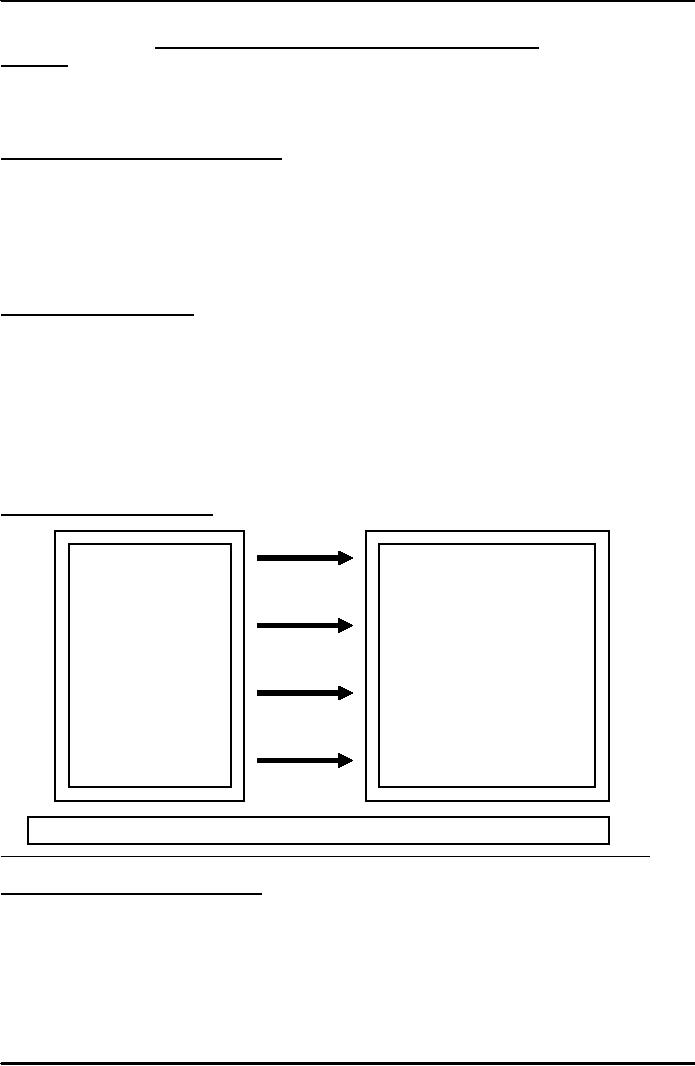 |

Fundamentals
of Public Relations MCM 401
VU
Lesson
5
PLANNING
PUBLIC RELATIONS
PROGRAMMES
Overview
This
lecture will explain about the methods
and essentials of planning
public relations program. It is
important
to consider and determine as to
how these can be planned for
tangible results. Although
once
again
we will be talking on broad scale
yet this can be adapted to
suit particular or more
modest
requirements.
4
Reasons for Planning PR
Programmes.
1.
Set targets for PR Operation
-- (Against which results can be
assessed.)
2.
Estimate the working hours
and other costs involved
for such PR Plan.
3.
Select priorities which will
control the number and timing of
different operations in the
program.
4.
Decide feasibility of carrying
out declared objectives
according to availability
of:
�
Sufficient
staff of proper caliber.
�
Specific
equipment like computers, cameras,
vehicles etc.
�
Adequate
Budget.
6
Point PR Planning
Model
In
order to plan a successful and
result oriented PR plan
following model should be adopted;
�
Appreciation
of the situation.
�
Definition
of objectives.
�
Definition
of publics.
�
Selection
of media & techniques.
�
Planning of a
budget.
�
Assessment
of results.
Let
us now study the above
enumerated parameters of successful PR
plan model individually.
Appreciation
Of The Situation
HOSTILITY
SYMPATHY
PREJUDICE
ACCEPTANCE
APATHY
INTEREST
IGNORANCE
KNOWLEDGE
NEGATIVE
SITUATION
POSITIVE
SITUATION
Methods
Of Appreciating A Situation
In
order to prepare an effective strategy to
counter a situation it is important that the
gravity of situation
should
first be assessed and
appreciated. Following are the
universally tried and accepted
methods of
appreciating
a situation.
�
Opinion,
attitude or image
surveys.
�
Press
clippings, monitored broadcasting
scripts.
�
Sales
figures trends & sales
report indications,
�
State
of competition within & from
imports.
12

Fundamentals
of Public Relations MCM 401
VU
�
Share
price if Public Company, dividends, balance
sheet etc.
�
Industrial
relation situation.
�
Customer
complaints, test reports & product
performance.
�
Discussion
with sales force &
distributors.
�
Prices
& effect of price changes.
�
Market
forces, economic, social &
political.
Definition
Of Objectives.
1.
Change
the image because company
has changed its
activities.
2.
Improve
the caliber of job
applicants.
3.
Tell
people about little known story of the
company & gain credit for
achievement.
4.
Make
company known & understood in new
local & international
markets.
5.
Prepare
stock market for a new
share launch.
6.
Improve
community relations following public criticism
based on misunderstanding of
company's
intention.
7.
Educate
installers, users or consumers
about the product.
8.
Regain
public confidence after a disaster
which had portrayed company as
inefficient in any
way,
the
cause having been rectified.
9.
Establish
a new corporate identity.
10.
Support
a sponsorship scheme.
11.
Make
politicians better informed about
company's activities, perhaps
because of some
impending
legislation
which
could affect the company
unfavorably.
12.
Propagate
company's research
activities.
When
we determine the objectives it is
essential that we should first of
all identify the public we want
to
target
from various publics, as
already enumerated in the previous
lectures also. Broadly speaking
there are
two
major publics classified as internal
and external while following
are the expanded
publics in
the
modern
day.
Expanded
Publics.
�
The
Community.
�
Potential
Employees.
�
Employees.
�
Suppliers
of services & materials.
�
Investors
--- the money market.
�
Distributors.
�
Consumers
& users.
�
Opinion
leaders.
Selection
of Media & Techniques.
Once
the objectives have been
worked out and the publics
selected, it will be necessary to
select the media
and
technique to be adopted for the
achievement of the desired objectives. It
is important as in relation to
the
objectives, determined publics
identified, only the selection of
proper public will yield
positive results.
Following
is the classification of different media
as in use in the present
days.
Electronic
Media
Print
Media
1.
Press.
1.
Radio
2.
Printed
Material.
2.
Television.
3.
Direct
Mail.
4.
House
Journals
Misc.
Media
1.
Exhibitions.
2.
Air balloons & ships.
3.
Electronic Bill
Boards.
While
determining the media and required
techniques it is essential and
important that before launching a
public
relations plan a budget should also be worked
out. In this context following is the
five point strategy.
13

Fundamentals
of Public Relations MCM 401
VU
5
Points For Planning PR
Budget
1.
To
determine, what will it cost to
carry out a PR Plan.
2.
What
sort of plan can be carried
out for a given sum of
money?
3.
After
agreeing to a cost & Plan, budget
provides a check list to tasks, to be
done as per a time table.
4.
Budget
sets a discipline for both expenditure
& over - expenditure.
5.
After
completion of campaign, results
can be measured against the
budget.
Assessment
Of Results
Once
all essentials like
objectives, proper identification of
publics and selection of
media and techniques
are
in
place and the cost involved
for such plan has
been worked out on the above
explained strategy, it is
imperative
that an assessment should be made
with regard to the public relations plan
about the results or
achievement
of the objectives on following lines
even if these may be
qualitative
and
not quantitative.
�
Evaluate
results.
�
Adopt
proper evaluating methods.
�
Compare
results against Objectives.
Sometimes
the results may not be
measurable statistically, but by
experience and self evident
qualities such
as
the evidence that now job
applicants are better educated
and more proficient or in
some other way
more
suitable
than before. These are
basically the qualitative results.
However, the quantitative results
may show
increased
sales, awareness and reduced
number of complaints, increased job
applicants, oversubscription of
shares
or even increased number of mentions of the
company name in the
media.
14
Table of Contents:
- INTRODUCTION & BRIEF HISTORY:Definitions Of Public Relations
- HOW DOES PR WORK?:OVERVIEW, Formulation of policy
- PUBLIC RELATIONS DISTINGUISHED:Size of a PR Department.
- PUBLICS OF PR:Expanded Publics, Few Examples Of Publics
- PLANNING PUBLIC RELATIONS PROGRAMMES:Print Media, Electronic Media
- MEDIAS OF PR:Media for External Publics, Principles of Good Press Relations
- PRESS RELATIONS IN PR:What is News, Secrets Of Good News Release.
- CREATED PRIVATE MEDIA:Private Media, New Forms of House Journals
- SPECIAL USES OF PUBLIC RELATIONS:Crisis Management, Skills Of PR
- BUDGETING IN PR:Labour, Office Overheads, PR & Photographs
- PUBLIC RELATIONS PROBLEMS:Defining PR problems, C’s of PR explained
- METHODS OF COMMUNICATION:Psychology of Public Relations
- PR IN VARIOUS ORGANIZATIONS:Techniques of Trade Association PR
- PR IN LABOUR UNIONS & RELIGIOUS GROUPS:Community Public Relations
- PR IN EDUCATIONAL INSTITUTIONS & IN MEDIA CHANNALS
- USING ADVERTISING FOR P R COMMUNICATION:Role Of PR
- ROLE OF PUBLIC RELATIONS IN MARKETING:How To Educate The Market
- PUBLIC RELATIONS AND CORPORATE STRUCTURE:Corporate Identity Essentials
- E-PR & ITS TOOLS:Immediate Points To Consider, Using Email As PR Tool
- SPONSORSHIP—AN IMPORTANT PR TOOL:PR & Communication Audit
- HOUSE JOURNALS:Possible Publics Of House Journals, Exhibitions & PR
- CRISIS MANAGEMENT IN PR:Plan Of Action Adopted, Interview at your place
- ADVERTISING IN PR:Broad Objectives Of Advertising, Direct Advertising.
- INTERNATIONAL PUBLIC RELATIONS:Media Used, Within Store Contacts
- PUBLIC RELATIONS CONSULTANCY:Disadvantages, Mass Communication
- PUBLIC RELATION’S ROLE IN MARKET EDUCATION:Kinds Of Markets
- MODERN DAY VALUES OF PR:Ethics Of Public Relations
- CHOICE OF MEDIA FOR PR COMPAIGN:Communication Channels & Media
- PR TECHNIQUES:Tactics & Techniques
- DESIGNING PR COMPAIGNS:Definitive Mission statement, Reputation.
- PUBLIC OPINION:Identifying Priority Publics, If Goal Is Attitude Change
- PUBLIC RELATIONS AND RESEARCH:Planning Phase Of Research
- PR AND RESEARCH:Unobtrusive Measures, Questionnaires For Survey
- PROBLEMS SOLVING STRATEGIES:Communicate results
- PERSUASION & COMMUNICATION THEORIES:Message Orientation
- COMMUNICATION CONCEPTS & THEORIES:Research and Persuasion
- PUBLIC RELATIONS & LAW:How To Stay Out Of Trouble
- PUBLIC RELATIONS & CASE STUDIES:Case Analysis, Images Of Public Relations
- PR AND PRINTING PROCESSES:Fundamentals Of Printing
- PUBLIC SPEAKING -- A PR TOOL:Key Benefits, How To Prepare
- PR -- COPING WITH UNEXPECTED:Some Possible PR Ideas
- DREAMS & REALITIES OF PR:Who Takes Charge Of Identity?
- CHANGING INTO OVERDRIVE:How International Is PR?
- GETTING ON WITH PR:Where does PR fit in the structure?
- FUNDAMENTALS OF A SUCCESSFUL NEWSLETTER:RESEARCH, WRITING